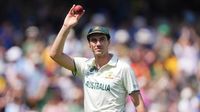Australia’s cricketing summer is fast approaching, and all eyes are on Pat Cummins as he races against time to regain fitness for the highly anticipated Ashes series against England. The 32-year-old Test captain and pace spearhead has been sidelined by a lumbar bone stress injury, first detected after he began experiencing back soreness following Australia’s Test series triumph over the West Indies nearly two months ago. With the Ashes opener scheduled for November 21 at Perth Stadium, the burning question is: will Cummins be ready to lead from the front?
In recent weeks, Cummins has been candid about his recovery process, offering a glimpse into his mindset and the team’s preparations. “I’d imagine (I’d want to be bowling) at minimum a month out, maybe six weeks,” Cummins told cricket.com.au. “But I’ve not thought that deeply about it yet. It’s still a bit of a wait and see. We’ve got plenty of time, so we’ll map a way back when we get closer.” For now, he’s taking it easy, focusing on light training with “not much running and zero bowling” for the next few weeks. That’s a cautious approach, but one that reflects the seriousness of his injury—especially given his history. Cummins’ career has been punctuated by stress fractures since his Test debut in 2011, and he famously waited six years for his second Test appearance.
The timing couldn’t be more critical. Australia’s Ashes defense is set to span five Tests—Perth, Brisbane, Adelaide, Melbourne, and Sydney—across the heart of the southern summer. The series not only stokes the fires of the oldest rivalry in cricket but also carries crucial World Test Championship (WTC) points. Australia currently sits atop the WTC standings, unbeaten in the current cycle, while England lags with a PCT of 43.33% after a mixed run against India. The stakes have rarely been higher; every match could shape the race to the WTC final.
Cummins’ absence from the field since leading Australia to the 2025 WTC title against South Africa and then the West Indies series has been keenly felt. To manage his workload and prioritize long-term fitness, he also skipped the white-ball series against the West Indies, South Africa, New Zealand, and India, as well as upcoming Sheffield Shield matches. It’s a calculated gamble, but one the Australian camp hopes will pay off come November.
Yet, Cummins’ injury isn’t the only headache for selectors. The pace stocks have taken a battering, with several other quicks facing their own battles. Lance Morris is out for the entire summer after back surgery. Jhye Richardson’s Ashes participation remains up in the air as he recovers from a dislocated shoulder. Queensland’s rising star Callum Vidler is sidelined long-term with a back injury, and young pacer Mahli Beardman is nursing a stress fracture. The attrition rate is enough to make any coach sweat.
Still, Cummins remains upbeat about the team’s depth. “A lot of planning goes in. It’s not just a month before, it’s 12 months out. Someone like Jhye Richardson—hopefully he will be available for some of the summer. There’s (Michael) Neser, Brendan Doggett was part of squads last year, Sean Abbott. So I’m really confident in our depth,” he said. Scott Boland, the reliable workhorse and the fourth member of the established attack, is ready to step in if needed. The selectors will be keeping a close eye on Shield and white-ball form to ensure everyone is “up and raring to go.”
Meanwhile, the narrative around Australia’s experienced pace trio—Cummins, Josh Hazlewood, and Mitchell Starc—has sparked plenty of chatter. Despite whispers about the group nearing the end of their Test careers, Hazlewood recently brushed off retirement talk, and Starc has confirmed he’s extending his red-ball career after stepping away from T20 internationals. The message is clear: the old guard isn’t done yet, and they’re determined to leave their mark on another Ashes summer.
On the batting front, speculation swirls about who will join Usman Khawaja at the top of the order following David Warner’s retirement. Several options have been trialed, but none have cemented themselves as a long-term opener. There’s also anticipation around the possible return of Marnus Labuschagne to the Test squad, a move that could bolster Australia’s middle order and provide much-needed stability against an aggressive English attack.
England, for their part, have reason to be optimistic. It’s been a decade since they last won the Ashes, but under Ben Stokes’ leadership and their much-discussed ‘Bazball’ approach, they’re eyeing a breakthrough. Their recent 2-2 draw in India’s Anderson-Tendulkar Trophy series has given them confidence, though their WTC campaign has been less consistent. The Ashes represents a golden opportunity for England to climb the standings and dethrone Australia on their own turf.
As the countdown to Perth continues, Cummins’ recovery remains the biggest talking point. The Australian skipper’s record speaks for itself: 71 Tests, 309 wickets at an average of 22.1, and an economy rate of 2.89. Few bowlers command as much respect, and his presence at the head of the attack is seen as vital to Australia’s hopes of retaining the urn. But the management is rightly cautious, given the risk of aggravating the injury and the packed schedule ahead.
“At the moment for the next few weeks it’s pretty light. Not much running and zero bowling,” Cummins reiterated. “We’ve got plenty of time, so we’ll map a way back when we get closer.” The Australian camp is banking on that time to work in their favor, with medical staff, selectors, and coaches all united in their support for a patient, measured return.
With so much riding on his fitness and the Ashes looming ever closer, Cummins’ journey back to the bowling crease is set to be one of the stories of the summer. The depth of Australia’s pace reserves will be tested, and the resilience of their captain will be on full display. As fans count down the days, one thing’s for certain: the Ashes drama is just getting started, and Pat Cummins’ comeback could prove pivotal in the battle for cricket’s most famous urn.





